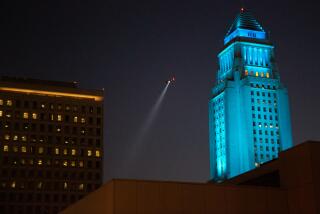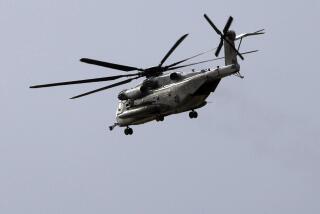Bin Laden raid reveals another elusive target: a stealth helicopter
When a U.S. military helicopter was destroyed in the backyard of Osama bin Laden’s compound, it left not only a pile of smoldering wreckage but tantalizing evidence of a secret stealth chopper.
The quest for a helicopter that can slip behind enemy lines without being heard or detected by radar has been the Holy Grail of military aviation for decades and until this week nobody had thought such a craft existed.
But aviation experts are now convinced that the Pentagon may have developed such an aircraft. They say the U.S. military went to extraordinary lengths to protect its new technology by destroying a helicopter that had been damaged in the raid, either during the initial landing or in the subsequent evacuation.
A section of the craft also survived intact, and photos of it leave no doubt in analysts’ minds that the U.S. had modified a MH-60 Black Hawk into some kind of super-secret stealth helicopter — the likes of which have never been seen before.
CIA Director Leon E. Panetta has said that the only helicopters used for the operation were Black Hawks, and he acknowledged that one of them had to be destroyed.
While stealth jets are designed to evade radar, stealth helicopters are built to be quiet. Some experts have concluded that the military and CIA may have succeeded in their decades-old quest to develop a helicopter without the ear-splitting thump-thump-thump that has signaled the presence of rotorcraft from miles away.
Maj. Wes Ticer, a U.S. Special Operations Command spokesman, declined to comment.
Aerospace analysts say the surviving tail section appears nothing like that of the standard $30-million Black Hawk chopper made by Sikorsky Aircraft Corp. in Connecticut. Notably, the tail rotor was partially covered by a plate or hub, possibly part of a noise muffling system.
“What we’re seeing here is a very different type of design than what we normally see in rotorcraft,” said Loren Thompson, defense policy analyst for the Lexington Institute in Arlington, Va. “It appears that the military went to great lengths to reduce the radar and acoustic signature of the helicopter.”
The tail section hints at what other modifications might have been made to the far more important main rotor.
Farhan Gandhi, aerospace engineering professor at Pennsylvania State University and deputy director of the Penn State Vertical Lift Research Center of Excellence, said tremendous advances in helicopter noise reduction have been made in recent years.
“You can never have helicopters make zero noise, but there is a tremendous possibility to make them much quieter than they are now,” Gandhi said.
To reduce noise, rotors can be slowed down. Advanced computation has enabled engineers to refine the shape of rotor tips. And research is being conducted into active controls that can make minute changes to the shape of rotors many times per second as they change position.
“The technology has been lab tested and flight tested, but it is not on any military aircraft that we know about,” Gandhi said.
Jeff Eldredge, a UCLA aerospace engineering professor and acoustics expert, said helicopter noise is extremely complex and requires many approaches to controlling it.
“The idea of a stealth helicopter is something of a misnomer,” he said. “It is very unlikely this is a helicopter you wouldn’t hear coming.”
But any reduction in noise could provide some tactical benefit.
The idea of quiet choppers is not a new one. During the Vietnam War, the U.S. Army and CIA developed what could be considered a stealth helicopter for the first time. Dubbed “the Quiet One,” it was developed by now-defunct Hughes Aircraft Co. in Playa Vista.
In the 1980s, the Pentagon worked on developing a classified stealth helicopter along with the F-117 Nighthawk stealth aircraft and the B-2 stealth bomber, said John Pike, director of GlobalSecurity.org, a website for military policy research.
The Army also tried to develop a stealth chopper, dubbed Comanche. But the helicopter program was canceled in 2004 after it incurred huge cost overruns.
No one knows for sure who worked on the modifications on the special forces’ Black Hawks or how many of them exist, but at least one may have been destroyed.
The Pentagon said the chopper experienced a mechanical “malfunction.” A senior military official who spoke on condition of anonymity because he was not authorized to talk about the incident said that the helicopter couldn’t get lift because of the 18-foot-high walls surrounding the compound.
The lift problem may have been caused by the modification to the aircraft, Pike said. The aerodynamics of the chopper could have been compromised in the process of making it stealthy.
The wreckage, some of which was carted away by the Pakistan military, has raised worries that key technology could be revealed to other countries, said Rebecca Grant, president of IRIS Independent Research, a military and aerospace consulting firm.
This year, China said it had developed and built a stealth fighter jet, dubbed Chengdu J-20. U.S. military officials believe that the Chinese used technology collected from a F-117 stealth aircraft that was shot down over Serbia in 1999 during the Kosovo war.
Chinese agents were said to have purchased parts of the plane from local farmers. The F-117 fighter uses high-tech coatings that act like a sponge to absorb radar waves as they strike the plane.
“There will be fears that the technology may get into the wrong hands,” Grant said. “But it’s not like you can just pick up a piece and reproduce it. This is extremely complicated technology. Most of us never have the chance to ever see it.”
David S.Cloud in The Times’ Washington Bureau contributed to this report.
More to Read
Sign up for Essential California
The most important California stories and recommendations in your inbox every morning.
You may occasionally receive promotional content from the Los Angeles Times.












